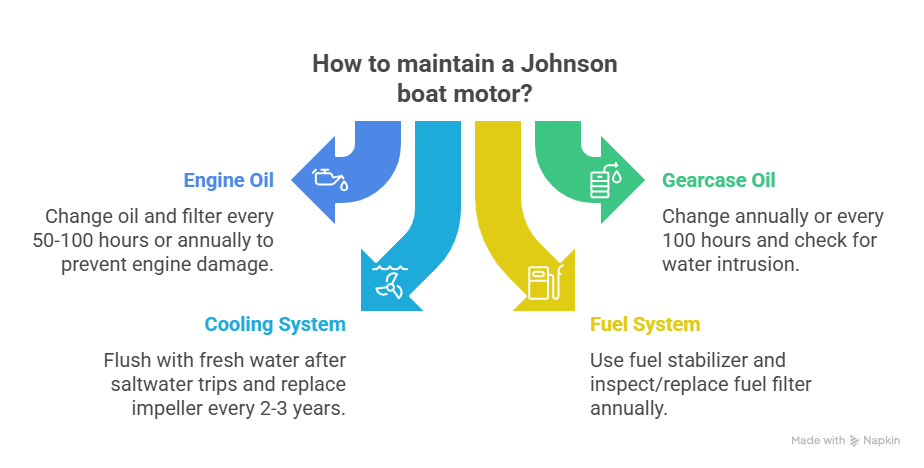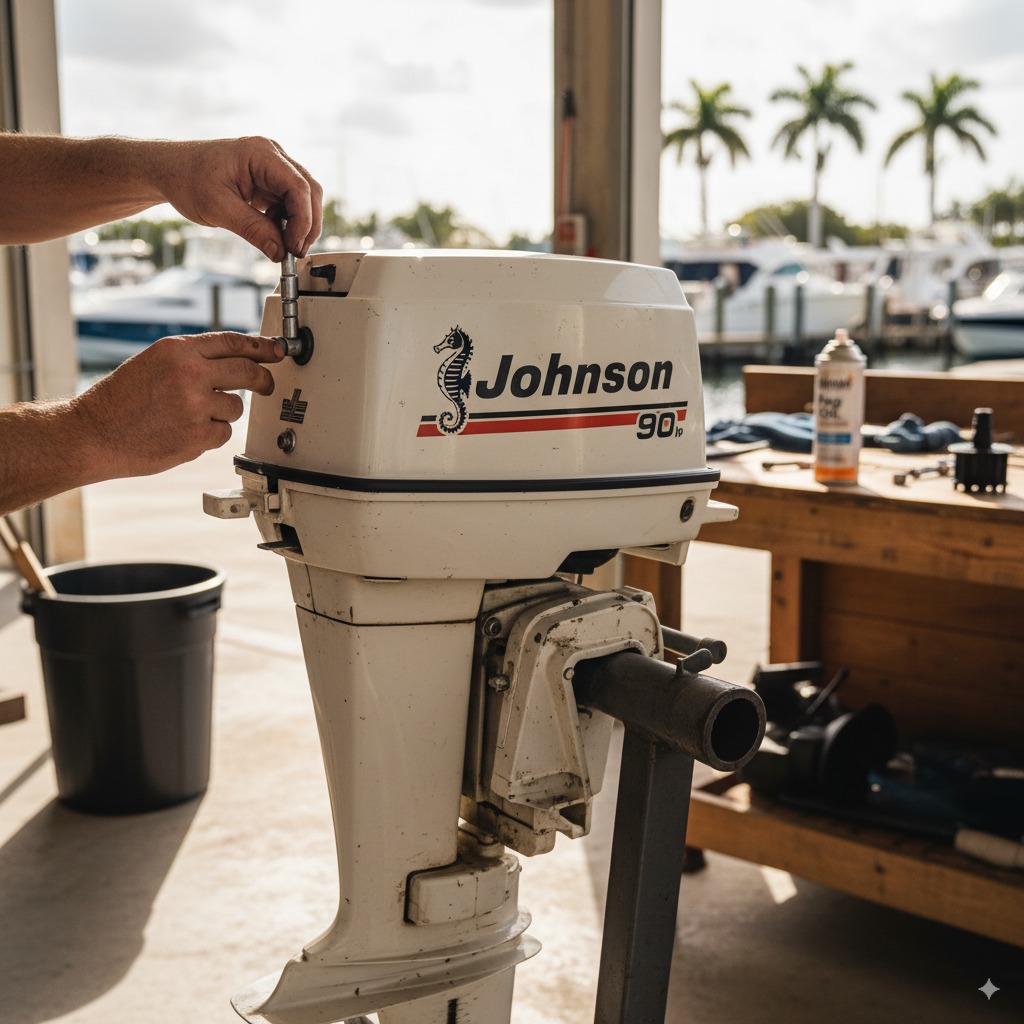These Old Motors Have a Soul
I’ve got a real soft spot for old Johnson outboards. They’re not flashy, they’re not packed with computers, but they are absolute workhorses. Last spring, a guy named Frank brought his classic Boston Whaler into my shop at Dinner Key. It had a Johnson V4 on the back that was older than my first truck. He said, “Alex, she’s running a little rough, but she’s never let me down.”
That’s the thing about these motors. You take care of them, and they’ll take care of you for decades. But “taking care of them” isn’t magic. It’s about consistent, smart work. Neglect is what kills them, especially the fuel system. So, I’m going to share some of my essential maintenance tips for extending the life of your Johnson boat motor, the same stuff I told Frank, and the same things I do on my own projects. This isn’t just about avoiding repairs; it’s about keeping a legacy alive on the water.
Table of Contents
My Go-To Checklist: The Stuff That Actually Matters
Forget complicated manuals for a second. If you do nothing else, focus on these core tasks. This is the foundation of any good plan of maintenance tips for extending the life of your Johnson boat motor.
1. Engine Oil: Don’t Get Cheap Here
For four-stroke models, clean oil is everything. It’s the lifeblood that keeps all those moving parts from grinding themselves into an expensive paperweight. I tell everyone to change the oil and filter every 50-100 hours, or at least once a year, no excuses. Use the oil spec’d for your motor. This is not the place to save five bucks.
2. Lower Unit (Gearcase) Oil: The Silent Hero
That lower unit is working hard, and its gear oil is under a ton of pressure. Change it annually or every 100 hours. Here’s a pro tip: I always look at the color of the old oil when it drains. If it’s milky, you’ve got water getting in through a bad seal, and you need to fix that yesterday before it destroys the gears.
3. The Cooling System: Keep Your Cool
A Johnson that runs hot is a Johnson that’s about to die. Flushing the engine with fresh water after every saltwater trip is the easiest, cheapest way to prevent corrosion. The water pump impeller is the heart of your cooling system. It’s a cheap rubber part that does a critical job. I recommend replacing it every 2-3 years, even if it looks fine. If your “telltale” stream is weak, that impeller is the first thing to check.
4. The Fuel System: The Achilles’ Heel
Especially on older carbureted Johnsons, the fuel system is where most problems start. Stale fuel with ethanol in it is poison. It gums up carburetors and fuel lines. Always use a fuel stabilizer if the boat is going to sit for more than a few weeks. One of the most crucial maintenance tips for extending the life of your Johnson boat motor is to regularly inspect and replace your fuel filter and check the lines for cracks.
Quick Maintenance Cheat Sheet
I give my clients a simple table to stick on their workshop wall. It’s a good starting point for your own routine of maintenance tips for extending the life of your Johnson boat motor.
| Component | Task | Frequency | My Two Cents |
|---|---|---|---|
| Engine Oil | Change Oil & Filter | 50-100 Hours / Annually | Use manufacturer-spec’d oil. No exceptions. |
| Gearcase | Change Lower Unit Oil | 100 Hours / Annually | Check for milky color—it signals water intrusion. |
| Cooling | Replace Impeller | 2-3 Years | Don’t wait for it to fail. It’s cheap insurance. |
| Fuel System | Replace Fuel Filter | Annually | The best defense against carburetor clogs. |
| Spark Plugs | Inspect & Replace | Annually / Per Manual | A fresh set of plugs can solve a lot of rough-running issues. |
| Anodes | Inspect & Replace | Every 6-12 Months | Replace when they’re 50% gone. They protect your motor from corrosion. |
Seasonal Care: How to Put Your Motor to Bed
If you’re in a place where your boat sleeps for the winter, proper storage is one of the most vital maintenance tips for extending the life of your Johnson boat motor.
- Winterizing: Run stabilized fuel through the engine before the final shutdown. Then, “fog” the cylinders with fogging oil—this coats the inside of the engine and prevents rust. On older carb models, I always drain the carburetor bowls.
- Storage: Keep the motor tilted down so all the water can drain out. A breathable cover is great for keeping dust off without trapping moisture, which leads to corrosion.
Properly winterizing your outboard is one of those maintenance tips for extending the life of your Johnson boat motor that pays huge dividends come springtime.

When to DIY and When to Call Me
Knowing your limits is key. You can absolutely save money doing some basic work yourself.
- DIY-Friendly Jobs: Changing spark plugs, oil, gear lube, and filters are all things most owners can handle with basic tools and a service manual.
- Call a Pro When: If the engine won’t start at all, if you suspect an internal issue (like that milky gear oil), or if you’re dealing with complex electrical gremlins, it’s time to call a professional. Guessing can get very expensive, very fast.
These simple maintenance tips for extending the life of your Johnson boat motor are about building confidence. The more you know your motor, the better you’ll be at spotting trouble early.
FAQ: Questions I Hear at the Marina
How can I figure out the exact year of my old Johnson?
Look for a small metal tag on the transom bracket. It will have a model and serial number. You can type that model number into a search online (sites like MarineEngine.com have great charts) and it will tell you the exact year. This is critical for ordering the right parts.
Is ethanol fuel really that bad for my old Johnson motor?
Yes, it is. Ethanol attracts water and can deteriorate old rubber fuel lines and gaskets. If you can find ethanol-free gas, use it. If not, a high-quality fuel stabilizer and water separator fuel filter are your best friends.
My “telltale” isn’t peeing water. What should I do first?
Shut the engine off immediately! Don’t run it. The most common cause is a clogged outlet. Gently poke a piece of stiff wire or a paperclip into the pee hole to clear any debris. If that doesn’t work, you likely have a bad impeller, and it’s time to replace it.
Can I use modern synthetic oil in my very old Johnson?
For four-strokes, absolutely, as long as it meets the manufacturer’s specs (like FC-W rating). For two-strokes, you need to use TC-W3 rated two-stroke oil. Sticking to the right type of oil is one of the most important maintenance tips for extending the life of your Johnson boat motor.
Is it worth it to rebuild an old Johnson motor?
It depends. If the engine block and core components are solid, a rebuild can give you a motor that’s good for another 20 years for a fraction of the cost of a new one. But if the block is cracked or severely corroded, it might be time to let it go. A good mechanic can give you an honest assessment.
The Bottom Line: It’s About Respecting the Machine
At the end of the day, all these maintenance tips for extending the life of your Johnson boat motor boil down to one thing: consistency. These old outboards aren’t disposable. They were built to be worked on and to last.
Frank, the guy with the old Whaler, put in a little effort. We cleaned his carbs, put in a new water pump, and got him on a schedule. He still sends me a picture every summer from some new place he’s explored. That motor is part of his family’s story now. With a little care, yours can be too.
Author Bio
I’m Alex, a 15-year marine technician in South Florida, ABYC-certified. I’ve probably rebuilt more classic Johnson V4s than I can count, and I have a deep respect for these legendary motors. From simple tune-ups to full overhauls, I’ve kept them running strong for boaters at marinas like Dinner Key and Bahia Mar.


Leave a Reply